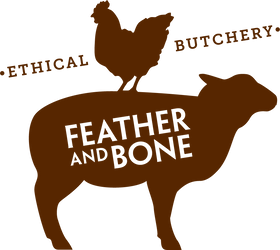How much water does it take to grow beef?
Monday 14 January 2013
Last week, the UK Institute of Mechanical Engineers published a report called ‘Global Food: Waste Not Want Not’ that concludes that 30-50% of all food produced never reaches a human stomach.
This is a disturbing statement. But it's very welcome if it brings the discussion about what food we're producing, why, how and where we're producing it and who we’re feeding, more prominently into the public sphere.
We haven’t had time to read the full report yet but a quick scan through the introductory information reveals a statement about the relatively high quantities of water required to grow meat versus vegetables – 15,415 litres of water for 1.0 kg beef and 287 litres for 1.0 kg of potatoes. Inevitably, there's the suggestion that we may all have to reduce or cease meat consumption because it's not sustainable.
We don't necessarily disagree with this, but we're a cynical lot here at Feather and Bone and we like to understand how these kinds of statistics are produced and how they'll be used.
For example, take the claim that it takes 15,415 litres to produce 1.0 kg of beef. This figure actually represents a whole series of very complex arguments and assumptions.
For a start, this figure could only be possible if you’re measuring grain-fed beef in feed lots, not pasture-fed cattle. It also points to a disturbingly low rate of efficiency and return in production. Which, I guess, is the whole point of the report.
We don't claim to be statisticians or to be fully across all the data but we wanted to see if layfolk like us could better understand the statistic.
So we asked Rob Lennon, owner of Gundooee Organic Wagyu farm, his opinion. According to Rob, in the current extremely hot and dry conditions, a two-year old cow on his property near Mudgee in New South Wales requires 20 to 30 litres of water per day. This doesn't include the moisture which the cow receives through the grass it eats and which, in turn, comes exclusively from rain fall. (No doubt the IME statistic considers average rainfall and multiplies that across the carrying capacity and output of an area. We're not sure about this idea either as it assumes that all rain that falls on a piece of land is used by the cow which is impossible, but let's not get bogged down.)
Based on this, we assumed an average daily consumption of about 20 litres for a grass-fed and finished cow. The cows we buy from Rob are usually about 26 months old and yield approximately 150 kg of consumable beef (not including bone, sinew or excess fat). So, assuming that a cow requires an average 20 litres per day for 26 months we calculate that 1.0 kg of consumable grass-fed and finished beef requires about 105 litres of water. (Remember that we’re talking about Australian beef produced on the driest inhabited continent.)
As we said, our figures are very rough and don't take into account factors such as average rainfall but it's very difficult to see how there could be sufficient additional measures that would take our figure from 105 litres to the staggering 15,415 litres of water per 1.0 kg of beef that's quoted in the report.
Unless, of course, the 15,310 difference is attributable to other factors including grain production, logistics, transport etc.
That's an awful lot of extra water usage. How have we arrived at a point where this method of beef production is considered best practice across the world?
On top of this, these figures don't quantify or compare the relative environmental impacts of growing livestock versus crops on marginal country. We'd argue that there is significant positive logic in running a herd of exclusively grass-fed bovines on land that might be unfit or impractical for crop production. Much better than growing cycles of mono crops of, say, genetically-modified grain on a piece of land that has to be kept viable with a constant stream of expensive pesticides, herbicides and chemical fertilisers.
Pasture is substantially naturally-occurring, it is the diet on which the animal is designed to thrive, it can be managed without expensive inputs, the grazing ruminants fertilise the soil as they go and, providing stocking densities are appropriate to the conditions, a herd of ruminants will leave soil and pastures improved. The more we intervene with the efficient optimisation of natural resources that ruminants offer, the more we need to intervene and the more problems we create.
We touched on this in a piece we wrote in November last year, The Miracle of the Ruminant.
'The key is how efficiently any given animal is able to convert the available feed, whatever the quality, into muscle and bone and sinew. Its also the apotheosis of the ruminant. To be able to take what can be found and extract the maximum value from it to build health and vitality. Chew and chew again. A simple equation apparently but one that is increasingly difficult to reconcile as more and more of the traditional genetics, especially of breeds like Angus, have been bent and stretched into new forms, with an eye to the feedlots who are looking for larger animals that will prosper on the high protein intake of a grain-based diet.
That may be thought of as a shame at worst or simply the inevitable development of selective breeding but to give up the hard-won benefits of efficient growth on limited intake is a folly. The critical point is whether the best of that 'easy-doing' genetics is still available.
Like food plants, the key genetics that form the basis of humanity's food inheritance are at serious risk. When the government talks of 'food security' it's safe to say that preserving and maintaining this genetic bank is not at the heart of their thinking, more's the pity.'
Nor do the IME's statistics take into account the relative nutrition and protein provided by 1.0 kg of beef versus 1.0 kg of potatoes, for example.
We believe that any solution to the food and water crisis must include a fundamental change in consumer attitudes toward food and consumption in general and part of that is definitely eating less meat. But we also think that the debate has to be had in the context of nutritional value and environmental impact and statistics taken out of context make good copy but sometimes reveal only half the story. We look forward to reading the full report.





Of course the two products are not comparable in quality, nutritional value, palatability, and also landskape impact.
Proteins are much more difficult to be produced than amid.
Leave a comment